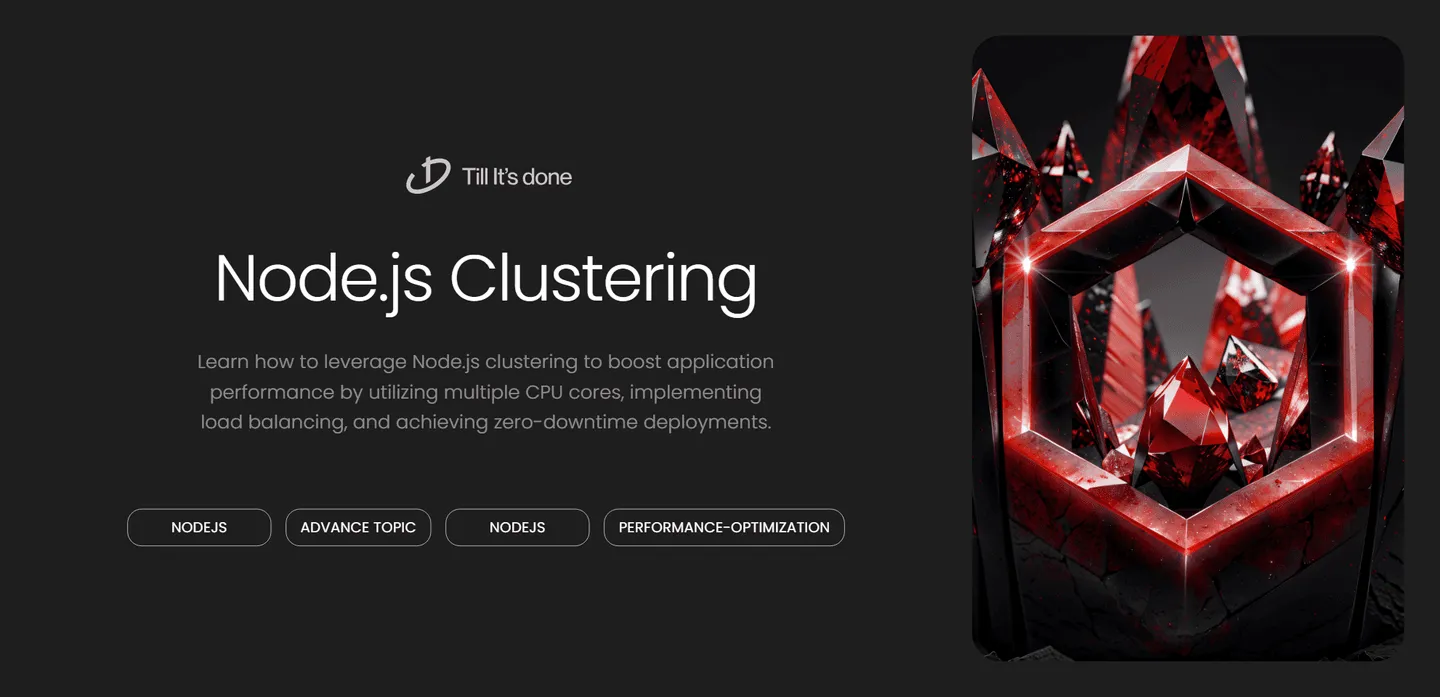- Services
- Case Studies
- Technologies
- NextJs development
- Flutter development
- NodeJs development
- ReactJs development
- About
- Contact
- Tools
- Blogs
- FAQ
Node.js Clustering for Better Performance

Leveraging Node.js Clustering for Better Application Performance

Node.js clustering is a powerful feature that can significantly boost your application’s performance by utilizing multiple CPU cores. Let’s dive deep into how you can leverage this capability to build more robust and scalable applications.
Understanding Node.js Single-Threaded Nature
By default, Node.js runs on a single thread, which means it can only utilize one CPU core at a time. While this is sufficient for many applications, it can become a bottleneck when dealing with CPU-intensive tasks or handling a large number of concurrent requests.

Enter Clustering
Clustering allows Node.js applications to create multiple worker processes, each running on a different CPU core. These workers share the same server port and distribute the workload among themselves, effectively increasing the application’s throughput.
Implementing Basic Clustering
Here’s a basic example of how to implement clustering:
const cluster = require('cluster');const http = require('http');const numCPUs = require('os').cpus().length;
if (cluster.isMaster) { console.log(`Master process ${process.pid} is running`);
// Fork workers for (let i = 0; i < numCPUs; i++) { cluster.fork(); }
cluster.on('exit', (worker, code, signal) => { console.log(`Worker ${worker.process.pid} died`); cluster.fork(); // Replace the dead worker });} else { // Workers share the same port http.createServer((req, res) => { res.writeHead(200); res.end('Hello World\n'); }).listen(8000);
console.log(`Worker ${process.pid} started`);}Advanced Clustering Strategies
Load Balancing
Node.js uses a round-robin approach by default to distribute incoming connections across worker processes. However, you can implement custom load balancing strategies based on your specific needs.
Zero-Downtime Deployments
You can implement graceful reloading of workers for zero-downtime deployments:
if (cluster.isMaster) { const workers = [];
// Graceful reload function const reload = () => { const oldWorker = workers.pop(); cluster.fork();
setTimeout(() => { oldWorker.disconnect(); }, 1000); };
process.on('SIGHUP', reload);}
Best Practices
- Monitor Worker Health: Implement health checks and restart failed workers automatically
- Memory Management: Monitor memory usage across workers and implement proper cleanup
- Logging: Implement centralized logging to track issues across all workers
- State Management: Use external stores like Redis for sharing state between workers
When to Use Clustering
- High-traffic web applications
- CPU-intensive operations
- Real-time data processing
- API servers handling numerous concurrent requests
While clustering adds complexity to your application, the performance benefits often outweigh the additional maintenance overhead for large-scale applications.

Remember, clustering isn’t always the best solution. For simple applications or those with limited traffic, the added complexity might not be worth the performance gains. Always profile your application’s performance before implementing clustering to ensure it’s the right solution for your needs.
 สร้างเว็บไซต์ 1 เว็บ ต้องใช้งบเท่าไหร่? เจาะลึกทุกองค์ประกอบ website development cost อยากสร้างเว็บไซต์แต่ไม่มั่นใจในเรื่องของงบประมาณ อ่านสรุปเจาะลึกตั้งแต่ดีไซน์, ฟังก์ชัน และการดูแล พร้อมตัวอย่างงบจริงจาก Till it’s done ที่แผนชัด งบไม่บานปลายแน่นอน
สร้างเว็บไซต์ 1 เว็บ ต้องใช้งบเท่าไหร่? เจาะลึกทุกองค์ประกอบ website development cost อยากสร้างเว็บไซต์แต่ไม่มั่นใจในเรื่องของงบประมาณ อ่านสรุปเจาะลึกตั้งแต่ดีไซน์, ฟังก์ชัน และการดูแล พร้อมตัวอย่างงบจริงจาก Till it’s done ที่แผนชัด งบไม่บานปลายแน่นอน  Next.js สอน 14 ขั้นตอนเบื้องต้น: สร้างโปรเจกต์แรกใน 30 นาที เริ่มต้นกับ Next.js ใน 14 ขั้นตอนเพียงแค่ 30 นาที พร้อม SSR/SSG และ API Routes ด้วยตัวอย่างโค้ดง่าย ๆ อ่านต่อเพื่อสร้างโปรเจ็กต์แรกได้ทันทีที่นี่
Next.js สอน 14 ขั้นตอนเบื้องต้น: สร้างโปรเจกต์แรกใน 30 นาที เริ่มต้นกับ Next.js ใน 14 ขั้นตอนเพียงแค่ 30 นาที พร้อม SSR/SSG และ API Routes ด้วยตัวอย่างโค้ดง่าย ๆ อ่านต่อเพื่อสร้างโปรเจ็กต์แรกได้ทันทีที่นี่  วิธีสมัคร Apple Developer Account เพื่อนำแอปขึ้น App Store ทีละขั้นตอน อยากปล่อยแอปบน App Store ระดับโลก มาอ่านคู่มือสมัคร Apple Developer Account พร้อมเคล็ดลับ TestFlight และวิธีอัปโหลดที่ง่ายในบทความเดียวนี้ได้เลย
วิธีสมัคร Apple Developer Account เพื่อนำแอปขึ้น App Store ทีละขั้นตอน อยากปล่อยแอปบน App Store ระดับโลก มาอ่านคู่มือสมัคร Apple Developer Account พร้อมเคล็ดลับ TestFlight และวิธีอัปโหลดที่ง่ายในบทความเดียวนี้ได้เลย  TypeScript Interface คืออะไร? อธิบายพร้อมวิธีใช้และข้อแตกต่างจาก Type เรียนรู้วิธีใช้ TypeScript Interface เพื่อสร้างโครงสร้างข้อมูลที่ปลอดภัยและเข้าใจง่าย พร้อมเปรียบเทียบข้อดีข้อแตกต่างกับ Type ที่คุณต้องรู้ ถูกรวมเอาไว้ในบทความนี้แล้ว
TypeScript Interface คืออะไร? อธิบายพร้อมวิธีใช้และข้อแตกต่างจาก Type เรียนรู้วิธีใช้ TypeScript Interface เพื่อสร้างโครงสร้างข้อมูลที่ปลอดภัยและเข้าใจง่าย พร้อมเปรียบเทียบข้อดีข้อแตกต่างกับ Type ที่คุณต้องรู้ ถูกรวมเอาไว้ในบทความนี้แล้ว  Material-UI (MUI) คืออะไร อยากสร้าง UI สวยงามและเป็นมืออาชีพในเวลาอันรวดเร็วใช่ไหม มาทำความรู้จักกับ Material-UI (MUI) ที่ช่วยให้คุณพัฒนาแอปพลิเคชันบน React ได้ง่ายและดูดีในทุกอุปกรณ์
Material-UI (MUI) คืออะไร อยากสร้าง UI สวยงามและเป็นมืออาชีพในเวลาอันรวดเร็วใช่ไหม มาทำความรู้จักกับ Material-UI (MUI) ที่ช่วยให้คุณพัฒนาแอปพลิเคชันบน React ได้ง่ายและดูดีในทุกอุปกรณ์  เปรียบเทียบ 3 วิธีติดตั้ง install node js บน Ubuntu: NVM vs NodeSource vs Official Repo แบบไหนดีที่สุด? เรียนรู้วิธีติดตั้ง Node.js บน Ubuntu ด้วย NVM, NodeSource หรือ Official Repo เลือกวิธีที่เหมาะกับความต้องการของคุณ พร้อมเปรียบเทียบ เพื่อการพัฒนาที่มีประสิทธิภาพ!
เปรียบเทียบ 3 วิธีติดตั้ง install node js บน Ubuntu: NVM vs NodeSource vs Official Repo แบบไหนดีที่สุด? เรียนรู้วิธีติดตั้ง Node.js บน Ubuntu ด้วย NVM, NodeSource หรือ Official Repo เลือกวิธีที่เหมาะกับความต้องการของคุณ พร้อมเปรียบเทียบ เพื่อการพัฒนาที่มีประสิทธิภาพ! Talk with CEO
We'll be right here with you every step of the way.
We'll be here, prepared to commence this promising collaboration.
Whether you're curious about features, warranties, or shopping policies, we provide comprehensive answers to assist you.


